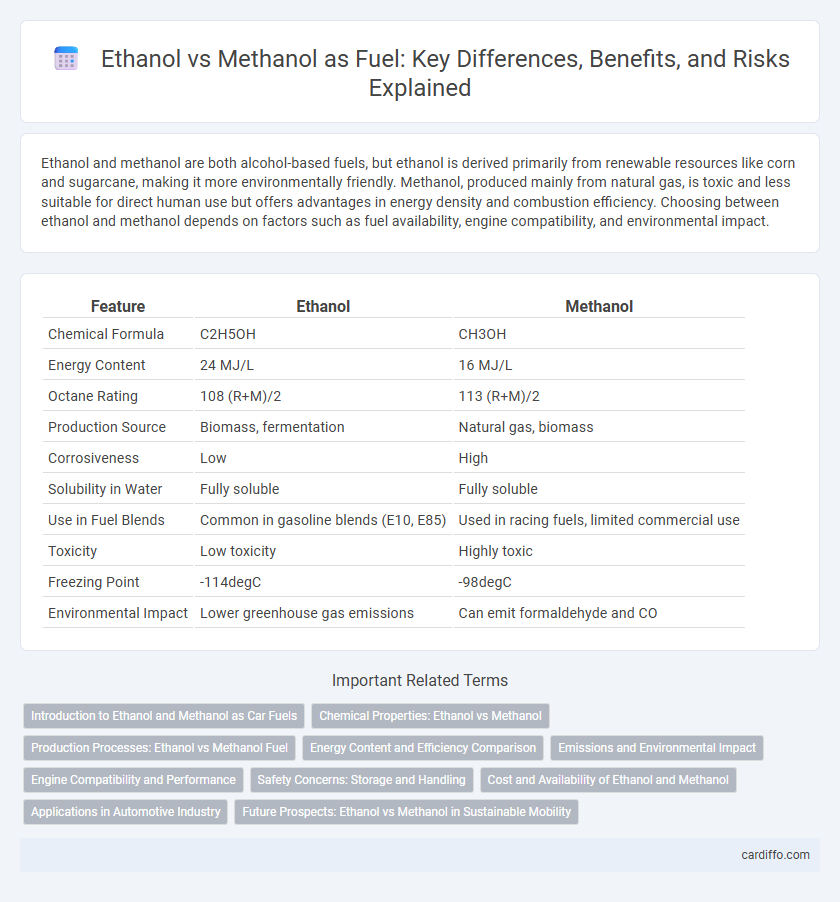Ethanol and methanol are both alcohol-based fuels, but ethanol is derived primarily from renewable resources like corn and sugarcane, making it more environmentally friendly. Methanol, produced mainly from natural gas, is toxic and less suitable for direct human use but offers advantages in energy density and combustion efficiency. Choosing between ethanol and methanol depends on factors such as fuel availability, engine compatibility, and environmental impact.
Table of Comparison
| Feature | Ethanol | Methanol |
|---|---|---|
| Chemical Formula | C2H5OH | CH3OH |
| Energy Content | 24 MJ/L | 16 MJ/L |
| Octane Rating | 108 (R+M)/2 | 113 (R+M)/2 |
| Production Source | Biomass, fermentation | Natural gas, biomass |
| Corrosiveness | Low | High |
| Solubility in Water | Fully soluble | Fully soluble |
| Use in Fuel Blends | Common in gasoline blends (E10, E85) | Used in racing fuels, limited commercial use |
| Toxicity | Low toxicity | Highly toxic |
| Freezing Point | -114degC | -98degC |
| Environmental Impact | Lower greenhouse gas emissions | Can emit formaldehyde and CO |
Introduction to Ethanol and Methanol as Car Fuels
Ethanol and methanol are alcohol-based fuels derived from renewable sources, widely considered as alternatives to gasoline for internal combustion engines. Ethanol, primarily produced from corn and sugarcane, offers higher octane ratings and lower emissions, making it a popular blend in gasoline. Methanol, often synthesized from natural gas or biomass, provides efficient combustion and cost-effective production but has lower energy content and higher corrosiveness compared to ethanol.
Chemical Properties: Ethanol vs Methanol
Ethanol (C2H5OH) and methanol (CH3OH) are both alcohols with similar molecular structures, but ethanol contains an additional carbon atom, which affects their chemical properties such as boiling points and solubility. Ethanol has a higher boiling point of 78.37degC compared to methanol's 64.7degC due to stronger hydrogen bonding enabled by its longer carbon chain. Methanol is more toxic and highly miscible with water, making it more reactive and volatile as a fuel compared to ethanol.
Production Processes: Ethanol vs Methanol Fuel
Ethanol is primarily produced through the fermentation of sugars derived from biomass such as corn, sugarcane, or cellulosic materials, involving yeast-mediated biochemical processes. Methanol is synthesized synthetically from natural gas via catalytic steam reforming to produce synthesis gas, followed by catalytic conversion into methanol. The renewable nature of ethanol production contrasts with methanol's reliance on fossil fuel feedstocks, influencing their environmental impacts and scalability as alternative fuels.
Energy Content and Efficiency Comparison
Ethanol contains about 24 MJ/L of energy, while methanol offers approximately 16 MJ/L, making ethanol more energy-dense and efficient as a fuel. Engines running on ethanol typically achieve higher thermal efficiency and longer driving range per liter compared to methanol. Despite methanol's lower energy content, its higher flame speed can translate to improved combustion in specific engine designs optimized for this fuel.
Emissions and Environmental Impact
Ethanol produces lower carbon monoxide and particulate matter emissions compared to methanol, making it a cleaner-burning fuel option for internal combustion engines. Methanol, while highly efficient with a high octane rating, emits formaldehyde and other toxic compounds that pose greater environmental and health risks. Lifecycle analyses show ethanol derived from biomass results in lower greenhouse gas emissions than methanol made from fossil fuels, contributing less to global warming.
Engine Compatibility and Performance
Ethanol offers better engine compatibility due to its higher octane rating and lower toxicity, making it suitable for flexible-fuel vehicles and reducing engine knocking. Methanol, with a lower energy content and higher corrosiveness, requires specific engine modifications and fuel system materials to prevent damage and maintain optimal performance. Both fuels improve combustion efficiency compared to gasoline but differ significantly in fuel system requirements and long-term engine durability.
Safety Concerns: Storage and Handling
Ethanol presents fewer safety risks in storage due to its lower toxicity and reduced volatility compared to methanol, which is highly flammable and toxic even at low exposure levels. Methanol requires stringent handling protocols, including adequate ventilation and protective equipment, to prevent ingestion, inhalation, and fire hazards. Proper labeling, leak detection systems, and spill containment are critical for methanol storage to mitigate its higher risk of poisoning and combustion.
Cost and Availability of Ethanol and Methanol
Ethanol is generally more cost-effective and widely available than methanol, benefiting from established production through fermentation of biomass such as corn and sugarcane. Methanol, produced primarily from natural gas, tends to have higher raw material costs and limited renewable sources, impacting its availability and price stability. The global infrastructure for ethanol distribution is more developed, supporting its broader commercial use as a biofuel compared to methanol.
Applications in Automotive Industry
Ethanol is widely used as a biofuel additive in gasoline, enhancing octane levels and reducing emissions in internal combustion engines, especially in flex-fuel vehicles. Methanol, though less common, serves primarily in racing fuels and as a potential alternative fuel due to its high octane rating and cleaner combustion properties. Both fuels contribute to reducing fossil fuel dependence, but ethanol's renewable sourcing and compatibility with existing infrastructure make it more prevalent in the automotive industry.
Future Prospects: Ethanol vs Methanol in Sustainable Mobility
Ethanol and methanol both play crucial roles in the future of sustainable mobility, with ethanol favored for its renewable sourcing from biomass and compatibility with existing gasoline engines. Methanol offers advantages in energy density and versatility, potentially sourced from renewable carbon dioxide and hydrogen, supporting fuel cell technologies. Scaling production and infrastructure development will determine their impact on reducing carbon emissions in the transportation sector.
Ethanol vs Methanol Infographic

 cardiffo.com
cardiffo.com